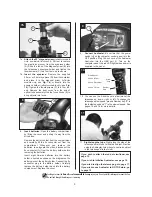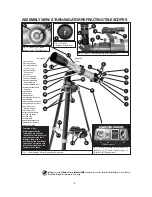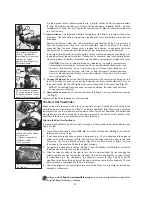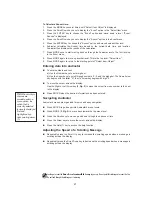
10
Looking at or near the
Sun
will cause
irreversible
damage to your eye. Do not point this telescope at or near the Sun.
Do not look through the telescope as it is moving.
DEFINITION:
Throughout this
manual, you will notice
the term "Alt/Az." Alt/Az
(short for altazimuth)
just means that your
telescope moves up
and down and from
side to side. Alt/Az is
one of many methods
used by amateur
astronomers to locate
celestial objects.
Fasten
wingnuts
Fig. 3 Attach Tray to the
tripod: Thread the wingnuts
to the bolts (bottom view).
Fig. 5: Attach the mounting
arm to the tripod base.
Fig. 4: Pads allow the
mount to move smoothly.
the Up Arrow key starts with the digit "9." The Left and Right Arrow keys are used
to move the blinking cursor left and right across the LCD display.
•
Alt/Az Alignment: Use the Up and Down Arrow keys to move the telescope
vertically up and down. The Left Arrow key rotates the telescope horizontally
counterclockwise, while the Right Arrow key rotates it clockwise.
g
Number Keys: Input digits 0 - 9 and changes the slew speeds (see
SLEW SPEEDS
, page
15). The "0" key also turns on and off the red utility light on the top of the handbox.
NOTE: While the audio descriptions are playing, the 7 & 9 keys adjust the speaker
volume. Press 7 to decrease the volume. Press 9 to increase the volume.
h
Scroll Keys: Accesses database options within a selected menu. The menu is displayed
on the first line of the screen. Options within the menu are displayed, one at a time, on the
second line. Press the Scroll keys to move through the options. Press and hold a Scroll key
to move quickly through the options.
The Scroll keys also scroll through the letters of the alphabet and numerical digits.
NOTE: The Scroll Down key and the Down Arrow key move forward through the
alphabet and digits (A to Z, 0 to 9). The Scroll Up key and the Up Arrow key move
backward (Z to A, 9 to 0). Common symbols are also available in the list.
i
? Key: While the audio descriptions are playing, the ? key will skip to the next audio file for
the selected object. If there is only one audio file for the object, pressing the ? key will stop
the audio. The ? key also accesses the "Help" file. "Help" provides on-screen information
on how to accomplish whatever task is currently active.
Hold down the ? key and then follow the prompts on the display to access details of
Audiostar functions in the Help feature. The Help system is essentially an on-screen
instruction manual.
If you have a question about an Audiostar operation,
e.g., INITIALIZATION, ALIGNMENT,
etc., hold down the ? key and follow the
directions that scroll on the second line
of the LCD screen. When a word
appears in [brackets], press ENTER to
access the Audiostar Glossary. A
definition or more detailed information is
displayed. Press MODE to return to the
scrolling Audiostar Help display.
When satisfied with the Help provided,
press MODE to return to the original
screen and continue with the chosen
procedure.
j
Coil Cord Port: Plug one end of the
Audiostar coil cord into this port (10,
Fig. 2) located at the bottom of the
Audiostar handbox.
1)
Coil Cord: Plug one end of the
Audiostar coil cord into the HBX port (A,
Fig. 1C) of the computer control panel
of the telescope.
1!
RS-232 Port: Plug an RS-232 cable into
Audiostar for downloading functions
such as "Download" or "Clone." See
page 27 for more details.
1@
Utility Light: Use this built-in red light to
illuminate star charts and accessories
without disturbing your eye's adaptation
to darkness.
Join an Astronomy Club
Attend a Star Party
A fun way to learn more about astronomy is to
join an astronomy club. Check your local
newspaper, school, library, or telescope dealer
to find out if there’s a club in your area.
At club meetings, you will meet other astronomy
enthusiasts with whom you will be able to share
your discoveries. Clubs are an excellent way to
learn more about observing the sky, to find out
where the best observing sites are, and to
compare notes about telescopes, eyepieces,
filters, tripods, and so forth.
Often, club members are excellent
astrophotographers. Not only will you be able to
see examples of their art, but you may even be
able to pick up some “tricks of the trade” to try
out on your StarNavigator telescope.
Many groups also hold regularly scheduled Star
Parties at which you can check out and observe
with many different telescopes and other pieces
of astronomical equipment. Magazines such as
Sky & Telescope and Astronomy print schedules
for many popular Star Parties around the United
States and Canada.












































